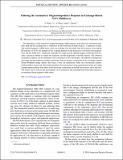| dc.contributor.author | Kilic, U. | |
| dc.contributor.author | Garcia, C. | |
| dc.contributor.author | Ross, Caroline A | |
| dc.date.accessioned | 2018-09-26T17:38:23Z | |
| dc.date.available | 2018-09-26T17:38:23Z | |
| dc.date.issued | 2018-09 | |
| dc.date.submitted | 2018-05 | |
| dc.identifier.issn | 2331-7019 | |
| dc.identifier.uri | http://hdl.handle.net/1721.1/118180 | |
| dc.description.abstract | The dependence of the asymmetric magnetoimpedance (MI) response on the directions of both the magnetic field and the exchange bias is studied for an [Ni-Fe(60nm)/Ir-Mn(35nm)]×5 multilayer system. The antiferromagnetic (AFM) layers create an exchange bias that shifts both the hysteresis loop and the MI response of Ni-Fe; the strength of this coupling depends on the thicknesses of both the ferromagnetic layer and the AFM layer. Tuning the exchange-bias angle and the applied-magnetic-field direction provides a practical method to control the symmetry and the magnitude of the MI response. The observed asymmetric response can be attributed to the coexistence of two anisotropies, the induced exchange-bias anisotropy and the magnetocrystalline anisotropy. Both are distinct components of the exchange-coupled Stoner-Wohlfarth energy density that forms a basis for simulations within the conventional Landau-Lifshitz-Gilbert framework. The model reproduces the main features of the experimental results, providing a deeper understanding of the effect of the anisotropy components on the MI characteristic curve and ratio. The results can be used for the development of an asymmetric MI exchange-biased thin-film element in an autobiased linear-magnetic-field sensor. | en_US |
| dc.publisher | American Physical Society | en_US |
| dc.relation.isversionof | http://dx.doi.org/10.1103/PhysRevApplied.10.034043 | en_US |
| dc.rights | Article is made available in accordance with the publisher's policy and may be subject to US copyright law. Please refer to the publisher's site for terms of use. | en_US |
| dc.source | American Physical Society | en_US |
| dc.title | Tailoring the Asymmetric Magnetoimpedance Response in Exchange-Biased | en_US |
| dc.type | Article | en_US |
| dc.identifier.citation | Kilic, U. et al. "Tailoring the Asymmetric Magnetoimpedance Response in Exchange-Biased Ni-Fe Multilayers." Physical Review Applied 10, 3 (September 2018): 034043 © 2018 American Physical Society | en_US |
| dc.contributor.department | Massachusetts Institute of Technology. Department of Materials Science and Engineering | en_US |
| dc.contributor.mitauthor | Ross, Caroline A | |
| dc.relation.journal | Physical Review Applied | en_US |
| dc.eprint.version | Final published version | en_US |
| dc.type.uri | http://purl.org/eprint/type/JournalArticle | en_US |
| eprint.status | http://purl.org/eprint/status/PeerReviewed | en_US |
| dc.date.updated | 2018-09-20T18:00:26Z | |
| dc.language.rfc3066 | en | |
| dc.rights.holder | American Physical Society | |
| dspace.orderedauthors | Kilic, U.; Ross, C. A.; Garcia, C. | en_US |
| dspace.embargo.terms | N | en_US |
| dc.identifier.orcid | https://orcid.org/0000-0003-2262-1249 | |
| mit.license | PUBLISHER_POLICY | en_US |
